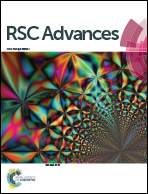Anisotropic hierarchical porous hydrogels with unique water loss/absorption and mechanical properties†
Abstract
Hydrogels with aligned porous structures have many potential applications. Introducing hierarchical porous structures into hydrogels might impart them with more and better functionalities. In this work, we prepared poly(2-hydroxyethyl methacrylate-co-acrylamide) [P(HEMA-co-AAm)] hydrogels with the directional freezing redox polymerization method by varying the molar ratio of HEMA to AAm. The P(HEMA-co-AAm) hydrogels have anisotropic hierarchical porous microstructures, i.e. large-area, thick lamellar structures aligned along the freezing direction are connected with thin lamellar bridges, forming macro-pores (several tens to more than 100 μm), and the large lamellar structures change from being dense to having many micro-pores. The large and long aligned channels provide a path for the unidirectional diffusion of solutions. The hierarchical porous structure and the hydrophilic nature of AAm lead to enhanced equilibrium water contents of the hydrogels, which can reach 95%. The hydrogels lose water under compression, the ratio of water that can be squeezed out reaches 66.7% of the total water content, and the squeezed gels can absorb water very quickly when swollen in water again. The hydrogels show anisotropic mechanical properties, with better tensile and compressive properties in the parallel direction. Interestingly, for the hydrogels synthesized with higher AAm molar ratios, their tensile stress–strain curves are almost linear. In addition, the hydrogels also exhibit perfect elastic recovery performance.


 Please wait while we load your content...
Please wait while we load your content...